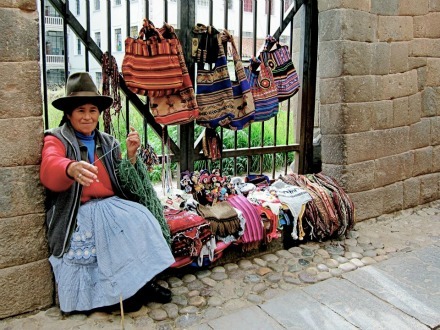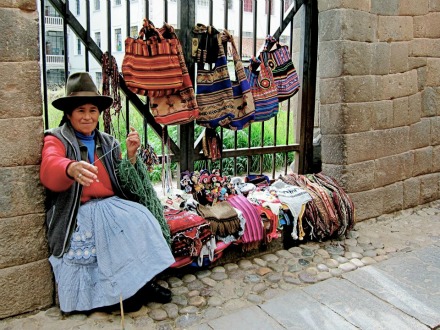Food Trekking: Cusco And The Sacred Valley Of Peru
Peru is well known for a rich history filled with Incan architecture, Spanish conquistadors, and American explorers. Machu Picchu, the Sacred Valley, and Cusco, are visited each year by throngs of adventurous travelers searching for the heights of Huayna Picchu and the bounty of the Urubamba River. And while few make the pilgrimage for the food alone, it's good enough to be worthy of a trip on its own.
We started in Cusco and ignored every piece of advice we got about altitude sickness (we'd skied at higher altitudes!), and suffered for it. Arriving midday, we set out to get a lay of the land around our lovely hotel, the Casa Andina Private Collection, which was mere moments from the Plaza de Armas. All of the natural beauty of the Sacred Valley is present (and for sale) in Cusco, which serves largely as a landing pad for people coming to and from Machu Picchu. Groups of young people walk the streets in brightly colored traditional costumes carrying small animals (baby goats, llamas) hoping for
We ate extremely well everywhere, which sounds impossible. But even our first lunch, at Greens in Cusco, was an incredible surprise of flavors. It's not a hole-in-the-wall discovery, it doesn't have a well-known Peruvian chef, and its menu is in English, but we stopped there short of breath and starving. It had also been recommended. We ordered ceviche, flatbreads with cheese from the Sacred Valley, a salad with local corn, and the "Carrot Cake French Toast." Every last bite was delectable and, despite catering almost entirely to tourists, really showcased the local ingredients.
The next morning we set our sights on Machu Picchu, taking the Vistadome train from Cusco, with its oversized windows and bright blue design. It's a 57-mile journey that takes 3 ½ hours. Our train had only two cars and was filled at 7 a.m. with energetic, camera-toting climbers. Having suffered through cup after cup of undrinkable airplane coffee, I was hesitant to order a cup on the train. But it was phenomenal — and I ordered round two as I drained the first. It was sweet without sugar, dark, and strong; it was an unexpected Peruvian gem, really, that was consistent no matter where we went.
But the feeling you get when the train pulls into Aguas Calientes — or Machu Picchu Pueblo depending who you talk to — is electric. No one knows quite what to expect, no matter how much research you do or how many pictures you look at. The town itself should not be passed over, even though it is really nothing more than a one- or two-night stay for most. It's a backpacker's village,
One of the girls in our hotel, the La Cabaña Machu Picchu, which seemed nondescript at first but within a night almost felt like home, recommended lunch at Indio Feliz, just off the main drag with a kitschy-cute design and an incredibly kind and multilingual hostess. Wary of how the place looked, we sat and browsed the menu, settling on the homemade bread; trout salmon with tomatoes, onions, and home-baked potato chips; and the beef broquettes. It was an enormous lunch, with little side dishes littering the table filled with various dipping sauces and homemade treats, and everything was lip-smackingly good. Frankly, I could have subsisted on the homemade bread and the salty yellow butter alone, but then there were the potato chips to polish off and the sauce on the fish. It was indulgent. That was one of the things that threw me off in Peru — even the cheesy places that you'd avoid back home or that seem too touristy serve unforgettable food.
That night, I put on the first pair of high heels that Aguas Calientes has seen in 10 years to dine in the restaurant at the cozy and intimate Inkaterra Hotel. Despite our indulgent afternoon lunch in town, we settled into seats overlooking the rushing Urubamba River and decided on the set menu. It was again a feast of homemade dishes using ingredients from the Sacred Valley like trout salmon and locally raised alpaca steaks, Peruvian and Chilean wines, and local Peruvian chocolates that made our taste buds melt. We felt more than fine about coming home with a few extra pounds if we got them like this.
And then the time came to wake up at 5 a.m. and join the rest of the trekkers at the bus stop to make our way to the Incan ruins in the sky — Machu Picchu. We'd read the stories of Francisco Pizarro's original conquest, of the fascinating farming practices of the ancient Incans, and of Hiram
We were lucky enough to be among the 400 people to climb Huayna Picchu, the adjacent mountain, that day, Dec. 31. (Machu Picchu means "old mountain" to Huayna Picchu's "young mountain".) We climbed up through pockets of fog and drizzle only to see a perfectly placed break in the clouds just as we summited that gave us an unparalleled view of the ruins. We snapped photos, stared in awe, high-fived each other for making it up the 1,000-foot hike, and practically skipped back down in giddy excitement. Perhaps the best evidence of the hike is the huge stamp they put in your passport once you make it back down.
We spent hours walking through the ruins, laying out on grassy knolls, and even saw a llama walking up some ancient Incan steps, before working our way back to the train station where we met our train, the phenomenal Orient Express-run Hiram Bingham. It is so fancy, they roll a carpet out in front of the entrance where a staff member meets you with hot towels. (Yes, I walked that mini red carpet in muddy Nikes, leggings, and a rain jacket.) Since it was New Year's Eve, our table was adorned with party masks, mini Peruvian instruments and noisemakers, champagne flutes, and the
The dinner consisted of ceviche served with local potatoes, lamb tenderloin with a pisco sauce, and salmon trout with Peruvian corn before we were led into the champagne-fueled dance party in the bar car, where dancers outfitted in wild "traditional" costumes grabbed revelers from the train to dance with them and waiters searched for flutes that were running low on bubbly.
Back in Cusco, having counted down to 2012, we slept like babies only to awaken, much to our amazement, starving. After coffee and home-baked pastries in our hotel, we were off to explore the other side of Cusco. We found a small local carnival where we shot fake shotguns to try to knock over super hero figurines and, as hunger pangs set in again around midday, we stumbled on a
Beside the stalls of freshly butchered meats, whole local fruits, and neatly packaged fruit cakes, we found small stands with local families sitting on long white benches in front of a single cook churning out plates of steaming, delicious-looking dishes. And so we fell in line, ordering a piping bowl of potato soup and a plate with rice, fries, tomatoes, and a fried egg on top (pictured). The entire meal cost us a mere $4 and was one of the most memorable of the entire trip. We broke the gooey yolk over warm rice and dipped crunchy fries into it, while the potato soup was thick and boldly flavored with heaps of herbs and chunky pieces of potato.
That night, we sampled Peruvian-style sushi at the long-loved LIMO Cocina. Going along with the surprise that even places which sit in seeming tourist-trap locations serve fantastic food, LIMO Cocina sits on Cusco's Plaza de Armas, the main square. We sat beside a window that overlooked all the evening's action on the square and ordered a handful of small dishes like alpaca skewers, a salmon sushi roll with sweet sauce, traditional causas, and tiraditos (a Peruvian-style sashimi).
As we departed for Lima the following day, our stomachs were full with the flavors that lined our memory banks and we talked through every morsel at our departure gate, on the plane, and in the cab to our Lima hotel. The whole jaunt was shocking and awe-inspiring for every sense, though our taste buds were easily the most surprised. It's hard to identify what surprised us most, though — was it the local flavors we hadn't anticipated? Was it that those ingredients were so cherished by every last locale? Or was it the people who took such pride in their ingredients that made us feel so passionate about them? The answer, like the ingredients themselves, must lie in the Sacred Valley.
(All photos courtesy of Nicole Campoy-Leffler and Jon Jackson)

